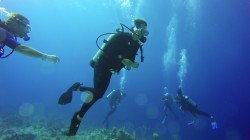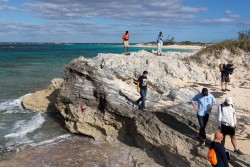Carbonate Geology of the Bahamas
October 14, 2016

By Charles Kerans, chair of the Department of Geological Sciences, Jackson School of Geosciences
The challenging syllabus for the Jackson School’s new GEO 193 Carbonate Geology of San Salvador, Bahamas, featured a unique prerequisite: open water scuba certification.
The goal of the class was to provide a holistic view of island evolution, including study of the Pleistocene “bedrock” of the island, the shallow marine environments of the surrounding shelf, shelf-edge reefs and the upper reaches of the slope apron, where enormous blocks that spalled off the reef front could be observed directly.

Professor Charles Kerans of the Department of Geological Sciences, Chris Zahm, a research associate at the Bureau of Economic Geology and Ph.D. student Andrea Nolting observed the reef wall and upper slope profiles along the margins of the Caicos Platform during their dives in 2015 and realized the importance of the steep reef wall profile and collapsed margins along the western and southern margins of the Caicos platform for understanding island evolution. They were not prepared, however, for the frequency and scale of collapse features observed by the class along the San Salvador margin during the 11 dives on the western wall that were part of class field work.
An imperfect analogy to the observed spalling of reef blocks from the vertical shelf margin is the calving of icebergs observed on the front of active glacial ice shelves, except the carbonate blocks sink and form a steep talus slope.
To build on the understanding of Pleistocene evolution of San Salvador, the class dissected the well-studied Pleistocene stratigraphy of the 125,000-year-old Cockburn Town reef system using high-resolution UAV imagery and high-resolution sequence stratigraphic analysis. The group hopes to develop and soon submit an abstract to an upcoming meeting with all students and faculty involved.
There are amazing outcrops around the coast of the island, as well as dramatic evidence of the erosive power of recent Hurricane Joaquin that hit the island in October 2015. Uniform agreement between students and faculty was that the combination of land, shallow water and deepdiving observations provided an unforgettable image of an evolving carbonate platform.
Back to the Newsletter